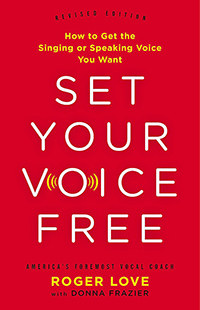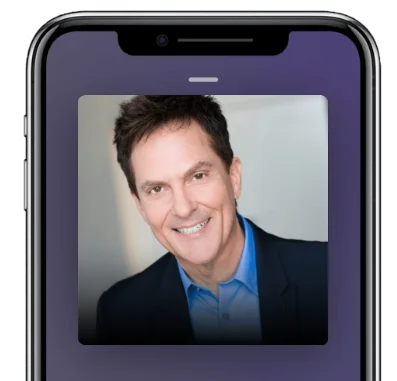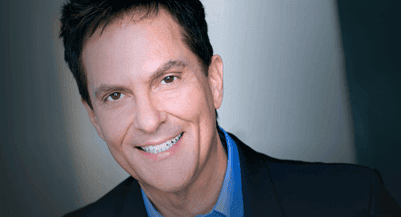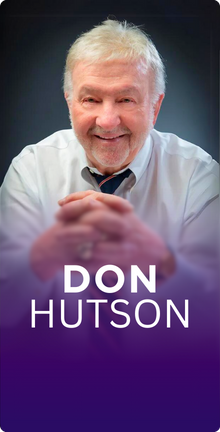In this Episode
- [02:23]Roger talks about his new book, Set Your Voice Free. In 1999, he had created a previous edition of this book, and he explains how he got started writing and why he’s creating a revised edition. The new book comes out December 27th, and some customized bonuses are available when you preorder.
- [05:47]We learn just how important the speaking voice is in social interactions. What Roger does is help people find their authentic voices. He reveals that he only focused on singers for the first 17 years of his career. He eventually realized that there’s no difference between singing and speaking, and began teaching speakers as well.
- [10:35]There are five components in voice, regardless of whether you’re singing or speaking: pitch, pace, tone, melody, and volume. Roger talks more about each of these components in some depth and demonstrates several of them.
- [18:28]Roger explains how influence is a major goal of communication.
- [19:20]Stephan steps in for a moment to translate what Roger has been saying into metaphysical terms. Roger then expands on the concept. They go on to discuss the role of body language and physiology in communication.
- [23:45]Roger tells us how to breathe in an effective way. He provides an exercise: open your mouth and take in a very slow (and airy-sounding) breath through your mouth. It makes the back of your throat dry, right?
- [25:31]Half of diaphragmatic breathing is simply breathing through your nose instead of your mouth. The other half is not raising your chest and shoulders when you breathe. This is how babies breathe, Roger explains.
- [30:29]Roger points out that we live in a mirror culture, and gives an example. This attempt to connect through imitation or mirroring is why we don’t use diaphragmatic breathing as adults despite doing it as babies.
- [31:05]Stephan asks a detailed question about singing between the chest voice and the head voice. Roger talks about the fact that there are actually three voices: the chest voice, middle voice, and head voice. He goes into some depth about the importance of the middle voice for singers and speakers alike.
- [35:06]Roger points out that boys and girls have the same vocal range before puberty. Once they reach puberty and boys’ voices change into men’s voices, the voices of men and women are immediately separate and sound very different. The middle voice allows men and women to have overlapping frequencies, which Roger argues allows the genders to communicate more easily.
- [39:00]People try to play all the different characters they must be throughout the day in one voice, Roger tells us. He gives an example and explains the importance of different voices.
- [41:39]Many people speak in a monotone. Roger talks about his stair-step method, which involves figuratively walking up and down the steps of pitch.
- [47:29]Roger talks about the online offerings he has for people who are interested in learning more. He keeps the price relatively low to avoid letting it be a barrier. He particularly recommends his Perfect Voice program. He generously gives Get Yourself Optimized listeners the free gift of this 3 Best Speaking Tips video.
- [50:10]Stage fright is an anticipatory fear, Roger explains. It tends to disappear within the first few seconds of actually speaking on stage.
- [51:20]Roger wants to help you develop your voice. In addition to the free video he provided, he suggests pre-ordering his forthcoming book Set Your Voice Free. It comes with a private website that has over 50 audio and video samples and a way of communicating with other people learning the same techniques. For a limited time, if you preorder before December 27th, you’ll also get three free gifts! (Note: you’ll need to use the included link when you preorder the book to be eligible to receive these gifts.)
- [52:15]Roger is also offering Get Yourself Optimized listeners a special discount on his Complete Perfect Voice Training System. For $50 off, use the promo code TRAINING (in all caps) when you order the program.
- [55:23]Roger is fully booked for the next year and therefore unfortunately isn’t generally available to be hired privately. He now spends most of his time creating content to reach (and help) larger audiences.

Roger, it’s so great to have you on the show.
Thank you, Stephan, for having me, I appreciate the time.
Let’s talk a bit about your new book, Set Your Voice Free. I understand that you’ve come out with the first version of this book like 1999 or so and then you’ve incorporated so much you’ve learned over the course of the last 16 years and new innovations and so forth. Tell us a bit about this new edition, this new book.
In 1999, I was teaching all of these very successful and amazing experts who were doing books like John Gray who had written Men are from Mars, Women are from Venus, and Tony Robbins, so many authors that I was working with. And I thought that’s it! It can’t be that difficult. If people are writing books and people are reading books, I’ll just write one. I wrote a proposal and I sent it around and I had a bidding war between six of the top publishing companies in the world to publish my first book Set Your Voice Free. It was a dream and that started my love of not only communicating audio-wise but actually writing the things down that I believe and being able to teach people through books. All of my books have accompanying audio programs so that you’re reading and also listening. Anyways, that was in 1999 but a lot has changed in the world of voice, both speaking and singing, since 1999. I got together again with Time Warner and Little, Brown, the publisher, and we’re doing a revised edition that I’m so excited about because it has everything that I’ve learned and everything that I’ve worked on and everything that I believe ever the last 16 years working with some of the most incredible voices in the world, the most influential voices. Every songwriter is most happy with the latest song they write and every author is the most excited about the latest book but all I can say is the new revised edition of Set Your Voice Free is the culmination of my entire life to this point and teaching people what they need to know about voice and it works.
Amazing. I can’t wait to read it. It’s not out yet, it’s going to be out December 27th. I guess those bonuses are to be announced, right?
They will be to be announced because I will customize them, especially for your group.
That’s awesome. Thank you so much for that. It’s just about to come out and there are all these people lined up to pre-order the book, it really gets the momentum going. Do help him out, he’s an amazing guy who’s changing the world one voice at a time and hopefully, your voice will be next.
Let’s prove that by how we can help your people today with what they need to know.
Exactly, and some people are public speakers already, some want to be speakers, some kind of casually sing but I think that everybody recognizes they have to communicate better, there’s always another level. Let’s help people to become better communicators. Maybe one of the ways that we could start is to break down what are the components, so the tonality, the pitch, the words, and so forth, and how we can help people adjust and optimize.

Beautiful. Alright, in order to do that, let me first say that the reality is the second you open your mouth and other people hear you, they make valued judgments about you, they start to ask themselves all kinds of questions about you. They don’t know you so they hear you speak and they decide unfortunately in about a second or two and science proves this. In a second or two, they’ve decided whether they like you, are interested enough in you to listen to what you have to say next. If we know that when we open our mouth and we start to speak, we don’t have the benefit of half an hour or an hour or a lunch or dinner for these people to get to know us. We have to immediately utilize all of the resources so that when we open our mouths, we’re showcasing ourselves in the best possible way so that people perceive us the way we want to be perceived.
For example, if you want to come across as the smartest person in the room, or the funniest person in the room, or the most giving person or the most loving person, there are sounds that are attached to all of those perceptions. In a nutshell, what I do is I help people find their authentic voices, the sounds that they should be making so that when they open up their mouths to have a conversation regarding relationships, or conversations regarding business dealings, or when they’re even thinking about how they feel about themselves, they’re communicating in a way that showcases the best of who they are. For the first 17 years of my teaching career, I focused absolutely only on singers. When I was 16, I was already the voice coach for The Jacksons and the Beach Boys and Earth, Wind and Fire, Stevie Wonder, and all of these artists that were so incredible and it was amazing that I even had the opportunity to work with them at all. I became part of the team that was their voice coach.
I really only taught singers for 17 years, and I got very, very good at making sure that those singers could control the sounds that come out of their mouths. I think you would agree with me, Stephan, that when a singer opens up their mouth and they sing, they have an incredible amount of influence over their audiences. If you’re at a concert and you’re sitting in the audience and the performer that you love sings a heartbreak song and it makes you teary-eyed and it makes you remember the first time you had your heartbroken, that’s a connection, that’s influence. If the singer got you to stand up in the aisles and dance and shake your little booty, that’s a connection, that’s influence. Singers have incredible amounts of influence over millions of people. A singer can get people to dress like they dress, vote like they vote, think like they think, and sing along with the words that they believe are important.
When I started about 17 years later all of a sudden getting calls from Tony Robbins and Suze Orman and experts like that that said we want you to work on our voices, in the beginning, I said I’m just a singing coach and maybe that’s not your best choice. But then I realized after a time that there was no difference between singing and speaking. That’s why I want to talk about answering your question that I realized over a lifetime that there’s no difference between singing and speaking, that the brain think it’s the same thing. When you’re singing, the brain just thinks you’re holding the words out a little longer and having more melody that you normally do. But other than that, it’s the same vocal chords, it’s the same breathing, it’s your body creating sound and sound coming out of your mouth.
Once I understood after a great deal of thought, learning, reading, focusing, working with laryngologists, working with speakers, came to the realization that I could teach the speakers, the influencers, the presenters, the business people, the people that wanted to be amazing communicators. I could teach them the same or very similar techniques that I was teaching my singers. That is that in voice, singing, and speaking, there are basically five components to understand. There’s pitch, pace, tone, melody, and volume. Pitch, either you speak really high like this, like Michael Jackson, and you don’t realize you’re speaking so high, or you speak way down low, way down here in the basement like maybe James Earl Jones. The pitch of the voice gives off subliminal messages to the people that listen. And when it’s down low, people feel certain things, and when it’s up high, people feel certain things about you.
Then pace, how fast or slow do you speak. You’re not realizing it but the pace of your voice and how you utilize pace is just as important in communication as it is in singing. There’s a reason that when you go to see an orchestra perform and the orchestra is doing, pararam.. and it’s getting faster and faster and your pulse is starting to race and you’re getting all excited, and there’s a reason when you hear music that is soothing and slower that your blood pressure lowers, that your pulse slows and you start to feel more open and romantic as opposed to getting up and dance. The pace of the voice, how fast or slow you speak matters.

Yeah. It could actually put you in a trance.
Absolutely! And as a matter of fact, people who are professional hypnotists have come to me for years saying what are the sounds I need to make to hypnotize people, to put them in that state. John Gray used to tell me that he used my exercises and it would help him meditate to a level that was far greater than any level he’d ever reached. He used to spend sometimes 10 hours a day when he was a celibate monk to try to reach a state of meditation. You have pitch, how high or low you speak, that matters. You have pace, how fast or slow you speak, that matters. You have melody, a song has a particular melody. You wouldn’t buy a song that just said, Johnny could only sing one note and he sang was this, here’s my song, I hope you like it, I hope you spend $1.29 at iTunes. What, you’re bored already, oh my. And yet, we speak with no melody. When we record ourselves, most people listen back and when they try to figure out how many notes they actually hit, or somebody like me tells them how many notes they hit like as if they were a piano, they’re shocked to know that they are only using one or two or maximum three notes. You’re walking around thinking that you have all this personality and yet you’re a broken-down piano with two notes.
Yes, there’s no range there.
There’s no range, there’s no melody and how you’re using melody is wrong. Do you know how many people go down when they get to a comma or a period? Here’s what I mean. We actually talk this way. When we’re taught English as a first language or as a second language, we’re taught that when we get to a comma or a period, we’re supposed to go down. Here I am speaking and I get to a comma, oh wait a minute I’m not done and then I get to another comma. Right? But this is how we learn. I’m taught when I get to a comma I’m supposed to go down in volume and I’m supposed to go down in pitch to a lower note. Basically, almost every sentence we speak, is a descending scale which means it starts higher and then it goes lower. I really like my dog. I love my wife. I love chocolates. Those descending melodies going from high to low and always going down in commas and periods like most people do and they don’t even realize it are making their listeners actually feel sad because there’s a tremendous scientific proof that talks about when you go from a high note to a low note, you’re making people sad. Why in the world would you want to make people sad when you talk to them when you have the opportunity of engaging them by making them happy and using melodies that go up? I love my wife. I love chocolate. I love my doggy. Melodies that go up, ascending scales.
Or I love my product. I love my service, I get to play inside and to buy your product.
I love everything about sounding happier because people don’t like to listen to people that are depressing. Melodies that go down, when they get to a comma, those people depress me and those people are not continuing the energy that I need to be engaged. We have pitch, pace, melody, volume. Most people are whisperers. They think they have a microphone in front of them so that they can just whisper, why should I have to be loud? I have a microphone, it’s right in front of my face, it’s attached to my lapel, the microphone will bring my voice to the audience. And that is bunk! What happens is you need to create a certain amount of volume and here is why. When I open up my mouth to speak, sound waves come out of my mouth and they are invisible and they leave my mouth and hopefully they go forward away from me and vibrate the bodies of the people that hear me.
What I spent my lifetime doing is figuring out how to teach pitch, pace, tone, melody, and volume so that you create a voice and different characters.
This is again proof, scientifically proven, I open my mouth, sound waves come out they vibrate the bodies of the people that are listening. If I speak really slowly, I don’t get enough sound waves coming out of my mouth and they go far enough away from me that they actually hit the listener’s bodies. When those sound waves hit the listener’s bodies, their brains interpret those sound waves into thoughts, emotions, feelings, they process them. If you’re not loud enough, you’re literally the worst FedEx delivery person on the planet. You’re the FedEx person that sits in the truck and hopes that somebody’s looking out the window and runs out to the truck to get the package. My communicators know that they have something great to give so they run out of the truck and they jump up the stairs and they climb up to the door and they bang on the door, and say, “Here’s the package you want.” We have pitch, pace, volume, melody and also tone which is how airy or how edgy we speak.
A lot of people think that if they spoke airier, that people would think that were sexy or they think that they were all therapists or were patient or loving but airy voice also sounds kind of dumb and inconsequential and unpowerful and not strong. If you’re trying to convey, “Oh, sign this deal, please. Sign the refined papers on the mortgage. Please, follow me into battle, please.” And you’re trying to do it with air, you are missing out. Literally, what I spent my lifetime doing is figuring out how to teach pitch, pace, tone, melody, and volume so that you create a voice and different characters that you play without voice that allows you to communicate in every situation and be authentic and influential and loving and honest and create a communication that opens up relationships and opens up business deals.
Persuades and influences and changes people’s lives.
Exactly. Why do you really want to open up your mouth if you can’t communicate in a way that influences someone. If you want somebody to be your friend but you can’t communicate in a way that effectively makes that happen, then you need to learn more.
Yeah.
If you want that person to be your boyfriend or girlfriend or marry you and you can’t communicate in a way that moves them emotionally, then you need to be a better communicator. If you can’t communicate in a way that makes people follow you or buy from you or believe you, then you need to be a better communicator. If you’re stuck in the rut of not having great relationships or not being successful in business and you’ve thought of everything else you could possibly think of, I’m telling you that the one thing you haven’t thought enough about are the sounds that are coming out of my mouth and how people are reacting to me or failing to react to me because of those sounds.
If you can’t communicate in a way that makes people follow you or buy from you or believe you, then you need to be a better communicator. Share on XYeah, makes a lot of sense. When you’re talking about volume as one of those five components, I got all kind of metaphysical there for a moment. I was thinking about energy transfer, if you are transferring your energy into another person so that they pick up on your vibrations and maybe you elevate their vibration, their state, maybe they get out of a funk or maybe they’re more inspired to change the world or make the world a better place if you are not showing up powerfully both literally and figuratively and projecting yourself and projecting those sound waves, there’s that disconnect and your energy transfer doesn’t happen.
Exactly right. Talking about energy transfer, let’s talk about how incredible you feel and how much it is self-motivating and how much self-confidence is built when you open your mouth and speak and communicate in a way that other people react positively to you so your energy is out. But when they react passively to your energy back, it feels incredible. When they give you the same kind of energy that you’re giving them, when you open up to them in an authentic, powerful, genuine, believable way and then you open them up and then they respond in the same way, you feel so incredibly self-confident. It is a win-win situation, you give that energy, they give you back that energy plus theirs, that’s an amazing feeling.
Yeah. Having that confidence even if you didn’t say a word, you just stood on stage, the body language that you project, your body positioning, how you hold yourself, the movements that you make, that conveys a lot to the listener, to the viewer.
Absolutely. They used to say in the 70s that statistics said that 7% of what you say, the words of what you say, makes you believable to an audience. Only 7%, so the words only count for 7%. Then they would say that physiology counts for 55% what your body is doing while you’re making sound. And then 38% of whether or not anyone believes you at all has to do with tonality, the things I’m talking about. Now, we realize those statistics were only partially right because the truth is that physiology has to be married to tonality. I cannot make any of the sounds I want to make unless I engage my physiology both internally and externally, how I breathe, how I take air in, how I send air out. I need to engage my physiology both with what I do with my arms and my legs and my eyebrows and my nose, but it combines with tonality so now we say that the words count for, if they’re lucky, 5% to 7% of whether or not anyone believes you. The rest of it, 95% has to do with what your body is doing while you’re making sounds. When you realize that, you’re coocoo to spend so much of your time trying to figure out the words you say, you need to first realize how you need to sound. Once you have that piece of the puzzle fixed, when you put the words into the right sounds, they complete the picture, then the words makes you an expert, but the sounds make you believable. The words make you a great teacher, but the sounds make you a great communicator because you’re changing people’s emotions. You’ve got to start from the sound first and you have to do the words in secondary position.
The words make you a great teacher, but the sounds make you a great communicator because you’re changing people’s emotions.
That makes a lot of sense. Now, if I’m wanting to improve the connection, that linkage between my physiology and tonality and perhaps learn how to breathe better so that I project myself better, so that I have more energy, and project that energy, what would be some breathing exercises or just some different ways to breathe while I’m up on stage?
Okay, perfect. Most people, because they have a big hole right above their chin called the mouth, most people think that the mouth is for breathing. When they breathe in, they try to take air in through that big hole called the mouth. What I would like you to do with me, and I would love all of the people that are listening right now to do with me is to open your mouth and take a very slow breath in like this. Just inhale and make that noise. Do you feel how dry that just made the back part of your throat?
Yeah. I got to get some water now.
One breath, one breath that you breathe into the nose just made your mouth dry and your vocal chords dry. That’s because, truth be told, we are not supposed to breathe into our mouths, we are born to breath in through our noses. There are filters in the nose called turbinates. When air passes to those filters, the air becomes moist air. Close your mouth, breathe into your nose. Go ahead, breathe in.
Okay.
You feel dryness?
No, not at all.
Zero. Most people are losing their voices halfway into the day or less than halfway into the day because they’re breathing into their mouths. You need to inhale only through your nose, that’s the first step, that’s one half of diaphragmatic breathing. I’m sure you’ve heard that phrase, diaphragmatic breathing, but most people think it’s more complicated than that. But 50% of diaphragmatic breathing is I just close my lips and I breathe in through my nose and now the air that comes in moistens my nose, moistens my vocal chords, and I’m ready to talk more and more and more because I have more relationships to make and I have more business deals to make and I have more people to teach and now my voice won’t be tired. That’s 50%. The second half of diaphragmatic breathing is not raising your chest and shoulders when you breathe. Most people when they inhale, their shoulders go up towards their ears and that’s not what you’re supposed to do. You’re supposed to pretend that you have a balloon in your abdomen. When you breathe into your nose, you are not supposed to move your chest and shoulders at all. You’re supposed to put your open hand on your tummy right where your abdomen, right above your belly button. Breathe into your nose and when you do this, pretend that you have a balloon in your abdomen and your job is to simply let your abdomen come forward as if you had swallowed a balloon. Take a breath through your nose and let your stomach come forward. Get it?
50% of diaphragmatic breathing is just closing your lips and breathing in through your nose.
Yup.
And then exhale out of your mouth and let your stomach come back in.
Okay.
This is vital to having an amazing voice, being a great communicator, being a great influencer, getting enough sound out, creating the right volumes, creating the right melody. Say this to me. Roger only wants me to speak, say that.
Roger only wants me to speak.
While my stomach is coming back in.
While my stomach is coming back in.
So I take a breath in through my nose, my abdomen comes forward, and then I speak, Roger only wants me to speak while my abdomen is coming back in. Say that with me.
Roger only wants me to speak while my abdomen is coming back in.
Most people don’t do that. Except you know who’s great at doing that?
Who?
Babies. And every single person who’s listening when they were babies, when they were infants, that’s how they breathe. That’s exactly how all babies breathe. They breathe into their nose, their tummy comes forward and then they’re stomach comes back in, pushing the air out. That’s what you need to create volume. Because as I let my stomach come back in, what happens? Now I’m like an accordion and just like the sides of an accordion comes back together, and pushes air out and sound out of the accordion. When my stomach, when my abdomen comes back in, it pushes air out of my mouth and what’s riding out on all that air? All the words, everything that I’m saying. If you’re not breathing into your nose, if you’re not letting your abdomen come forward and then letting it come in when you speak, you’re holding your breathe the entire time. I’m doing it right now, I’m holding my breath the entire time I’m speaking, so I’m certainly not letting my stomach move and this is the sound I make. It sounds like I fixated myself like I am choking and here’s how most people talk because their stomach isn’t moving. But now watch, I’m going to take a breathe and I’m going to let my stomach come in, now all of a sudden I got more volume, more resonance, more bass, more beautiful sounds in the voice because I’m restricting the air out. In a nutshell, you just need to learn how to do diaphragmatic breathing. It’s not hard, you’re just not used to it and you need to go back exactly the way you did it when you were a baby. You need to relearn what you were born already knowing and I want to help with that.
In a nutshell, you just need to learn how to do diaphragmatic breathing.
Yeah, that’s great. I don’t know why we stopped breathing that way because it’s so much healthier. Maybe it’s because we got self-conscious about our stomach’s poking out or whatever.
The reason that happens is because most people don’t do diaphragmatic breathing. I absolutely adore my parents, and you should adore your parents to the level that you feel is appropriate, but most of them weren’t doing diaphragmatic breathing. When you grew up, you not only learned their accent and their dialect and you started to comb your hair the way that they did and you started to dress the way they did. You also imitated their breathing patterns so when your mommy was like, “Do you want some lunch?” And she was breathing up with her chest and shoulders and you were breathing up with your chest and shoulders imitating her because you wanted lunch. You thought it connected you better.
Yeah, that makes sense.
We live in a mirror culture. I’m walking down the street and I see somebody walking towards me that I don’t know, and they’re like, “Howdy?” Before I can even stop myself, I’m like, “Howdy?” I never said howdy in my life and I don’t even look good in a cowboy hat. Why did I say howdy? Because we’re trying to connect with people. We imitate them, we imitate the way we see other people breathe, we imitate the way we see other people speak. Learn how to speak and learn how to breathe and let other people imitate you for the betterment of them and you.
You had a free video training on chest voice, that was really interesting because I have this problem where I can sing in my head voice, I can sing down low, I have a deeper voice. I forgot what’s that called. There’s this middle voice that I didn’t even know existed and I just can’t sing between those two. Does that have to do with breathing as well?
Yes, because what you’re talking about is that most people, first of all, you’re not silly for not knowing about the different voices because nobody taught you all about the different voices. But most people believe that there are only two voices in the human voice. There’s a voice down low, which we call the chest voice which most people, other than Michael Jackson and sometimes David Beckham, most people are down here in chest voice and they talk like this, man and women. Then there’s a voice called head voice which is way above chest voice and head voice is way up here. Here I am in my head voice and here I am with my chest voice. Most people think that there are only those two voices. God forbid if they try to sing and go from low to high, what happens? They break. They go from low to high and there’s no bridge that connects the chest voice to the head voice because they’re only thinking there are two voices. I learned early on in my life and I’ve forwarded this technique and really created an awareness that there’s another voice called middle voice that actually lives in between chest below and head voice the high. It is a beautiful, gorgeous, amazing area in the human voice that creates sounds that are passionate and strong and focused and beautiful.
There’s another voice called middle voice that actually lives in between chest below and head voice the high.
Let me demonstrate all three. I already demonstrated two. Chest, head voice, middle voice, in between the two. An area right in between the two. When I show chest, middle and head to a singer or someone who wants to be a singer, they think that they have just had an epiphany, that their lives had been changed because they’d been straining, struggling as they go high. When I show it to a speaker or influencer, presenter, doctor, lawyer, communicator, teacher, they’re like, “Roger, what do I need middle voice for?” And then I say, “Well, my dear teacher, influencer, speaker, presenter, amazing communicator, if you don’t have middle voice, you cannot have a healthy voice because you were born to have all three. If you don’t have middle voice, it’s like you’re speaking and as soon as you get a little bit higher in the range, it’s like you’re hitting your head on the ceiling. You don’t have the sounds and the tone and the range and you can’t create the melodies that I can create. If you don’t have middle voice, there’s a part of the range where you cannot move people emotionally in certain ways because certain parts of middle really move people emotionally.
You can’t be healthy, you can’t have a voice that’s as beautiful, and you can’t communicate in an emotional way only having chest voice or head voice and this is going to blow you away. Here’s a really interesting thing why you need to have all the three voices. When boys and girls before puberty, their voices are exactly the same place. If you try to figure out what notes they are on the piano, they’re exactly in the same place on the piano, are you with me? When puberty happens, a male voice drops an octave lower. Before that happens, boys and girls are communicating in a way that they sound similar to one another. There is all kinds of evidence now that proves when you sound similar to one another, you have an extra level up of being able to communicate with one another because as I said we live in a mirror culture. When a little boy and a little girl talk, they become less aware of the gender differences and they communicate more freely because they’re both making similar sounds. But when a boy’s voice becomes a man’s voice and drops an octave lower, sonically, sound wise, he is immediately separated from a woman’s voice because a woman’s voice never drops down low. At that moment when young men and young women are communicating, they sound differently and I believe that it’s partially due to that sound difference that creates more of a barrier or more of a blocked communication that isn’t as open when their voices were the same.
Now all of a sudden are thinking boys are different, and boys are thinking girls are thinking girls are different. Yes, they are different but it makes it harder for them to communicate in a way that they’re sharing the same frequencies, making the same sounds, feeling like they’re more connected. Guess what? What is middle voice about? There are frequencies in that middle voice, when a man learns to connect his middle voice after puberty, he gets up into that range where a woman goes. And when a woman learns to utilize her chest voice a little bit more and her middle voice, she gets into that range. It’s a place I call overlapping frequencies. By learning chest, middle and head and communicating across genders, I found a way of making the communication easier because there are specific notes that we share. Isn’t that interesting?
That’s amazing. It reminds me a little bit about color blindness, not that I have it but that concept of having part of the spectrum unavailable to you because just the way that you’re wired genetically and it sounds like there’s kind of an auditory counterpart, they just didn’t know what they didn’t know. They didn’t know that there’s this middle voice and so that whole range becomes unavailable and thus they’re not as powerful communicator, they don’t have the full range.
I 100% agree. Women are going into business meetings and they’re thinking, should I try to sound like a man or should I try to sound like a woman? Men are going into conversations with women and they’re like, should I sound more manly? Or should I sound a little higher and try to make her think that I want to be her boyfriend and her girlfriend. Everyone’s confused, and what they need to know is that they need to have all of the range, chest voice, middle voice and head voice and they need to move in and out of those places in the same way that you go to a concert and you don’t just want the artist to sing nothing but ballads the whole time.
I help people find their voices. People have been playing all of the different characters in a day with the same voice.
And it doesn’t have to be all jerky, it could be really smooth.
Exactly right. What happens is I help people find their voices and then they realize that they’ve been playing all of the different characters that they play in a day trying to do with the same voice. Let me explain. I’m a teacher during the day and I see students, and I have my teacher voice which is big and thick and strong. I know lots of things and I’m very passionate about the things I know. If I come home to my wife with my teacher voice and I burst in the door with my teacher voice, she’s like, “Yow, I don’t know who you think you are but take the trash out, buddy.” My teacher voice does not work on my wife. She doesn’t want to play student, this isn’t roleplay. She wants to be wife, she wants to be partner, she is. I have to change my voice and I want to change my voice when I come home at night. I get into my husband voice which a much better listener, which is softer that my teacher voice, which leaves longer pauses when I get to a comma so that she can tell me more about what she wants to tell me about. I change my voice for that.
When I see the kids and the kids come running towards me, if I’m so lucky after the dog which I know will come running to me and lick me on the face, if I’m so lucky and the kids come running towards me, I can’t use my husband voice on my kids. I have a voice that I use as a father which sounds strong and loving. What we don’t understand is you’re trying to play all that roles that you do. You go to work and you play that role and you have your voice and the way you communicate, then you come home and then you have your voice, and then you have your friends, and you have people that you’re trying to influence and you’re in the elevator and you’re trying to make your elevator pitch and you using the same voice all the time. What you don’t realize is that maybe you need more colors, maybe you need more range, maybe you need more control of your voice so that you’d be able to move in and out of all of the possibilities and ways that your voice and you can showcase all these different characters would result in a positive outcome for all of those relationships, all of those communications, all of those business deals.
Pretty cool. Let’s give a focus on another kind of tangible tool they can take away and start using immediately. One thing I learned from you was the stair-step melody and how much easier that is for people to follow you on a journey then versus randomly jumping up and down and just jerking them around.
Perfect. When I tell people to record their voices and they record their voices and they sound like this, I’m just talking on the same note over and over again and I’m an interesting person, I went to college and I have kids and I have a white dog and I drive a white car and this is boring. They stay on one note and that’s called monotone. I say you need more melody. What they do is they’re like, “Okay so Roger says I have to jump from low notes to high notes and this sounds silly, this would be maybe fine if I was auditioning to be a clown but I don’t want to be a clown. And yet Roger says I’m monotone so I have to have more melody.” What they don’t understand is I need to give them a simple way of thinking about melody and here it is. It’s called stair-step melody and that’s exactly what you brought up. There are really three directions of movement you can do on stairs. You can walk up the stairs, you can walk down the stairs, or you can stay on one stair and not go anywhere.
Here’s an example of me walking up the stairs, now I’m walking up the stairs, so I’m going from a low note to a little bit higher, to a little bit higher, I’m not taking giant jumps, I’m not going now I’m walking up the stairs! I’m going now I’m walking up the stairs so there’s just a little bit of going higher tiny bit, tiny bit, tiny bit, that’s walking up the stairs. You need to practice walking up the stairs, going from a low note to a high note. Starting out lower and then moving higher without taking giant jumps. Small steps up the stairs. Then, you could be also walking down the stairs, now I’m walking down the stairs. Now, I’m walking down the stairs which I showed you earlier and I called it descending melody, a descending scale. Now I’m walking down the stairs, so again I’m not taking giant jumps, I’m not taking giant jumps, very, very small steps. My staircase has tiny, tiny, tiny little steps. Whether I’m walking up the stairs or whether I’m walking down the stairs, or the third movement, here I am standing on the one step or the landing.
Melody is one of the main key factors as to whether or not you’re moving people emotionally.
We are very, very, very good at standing on the landing and being monotone but we need to get really better at walking up the steps, taking small, little, incremental movements in pitch. You might say to me, ”Roger, I am not a singer, I don’t have that kind of tone.” You have enough awareness to record yourself and practice reading, speaking, talk about lunch, talk about dinner, talk about something you’re passionate about. “I really like golf, I can go from lower to higher, now I’m going from higher to lower, now I’m going from lower to high, now I’m going from higher to low, now I’m standing on the landing, staying on the same step.” If you just practice going up and down these tiny stairs steps, you’ll understand how to incorporate melody in your voice. When you’ve learned how to incorporate melody in your voice, people will react to every sound that you make differently because melody is absolutely on the top of the list. One of the main key factors as to whether or not you’re moving people emotionally, melodies matter.
Check this out. “Do you want to go to the movies? Do you want to go to the movies? Of course you don’t want to go to the movies with me, I’m a freak.” How about his? “Do you want to go to the movies? Do you want to go to the movies?” “Okay, can I bring my kids? Sounds like we’re going to a G-rated film. Let’s go to the movies.” How are melodies less important in speaking than they are in songs? Answer, they’re not. Learn how to do stair step melody, you’ll move people emotionally. The goal is when you open your mouth, are you making people feel something? The goal is when you open your mouth, are you controlling the perception of other people? When you open your mouth, are you predetermining the outcome of the conversation because you got them to know you and to feel. If you can’t do those three things, you need better breathing, you need better melody, and you need to stop worrying about how your hair looks and you need to focus on you voice.

Got it. Combining what you were just talking about with the stair-step melody with what you were talking about earlier about not ending your sentences or phrases where there’s a comma with a down and quieter volume as well. But instead ending up, combining these two ideas so that you have vocal variety in a way that inspires people, gets them happier instead of getting them depressed, big difference there. I love all of this stuff. You have lots of online training, correct? I just watched a bit of your online training that you had made as a free video series. But you have a lot of other videos that are paid to teach all these sort of techniques as well. Correct?
Yes. And I have them all at a price points that makes them incredibly affordable because my goal is to change the world. I have to do it with my expertise which is one voice at a time. I make my programs available at a cost-effectiveness that is a no-brainer-no-barrier to people who want and now understand that they haven’t focused on voice and that’s why they’re not achieving the success that they want. We’ll give you a link, you’ll post a link to what is my most well-known program called The Perfect Voice which is all audio, which teaches you so much of what I know and gives you specific exercises you’re supposed to practice with and really goes more into detail about pitch, pace, tone, melody, and volume and also creates what I call The Vocal Profiles.
For example, you want to go in and ask for a raise, how much pitch, pace, tone, melody should you have, this will help you understand. Let’s say you want to ask someone out on a date, how much pitch, pace, tone, melody, and volume should you have? Let’s say you’re interested in sales, how much pitch, pace, tone, melody, and volume should you have? We create these vocal profiles which are really, really good tools to get yourself in the ballpark of understanding the way that you sound for specific communications that you’re having all of the time. A perfect voice is a great place to start. I feel so moved by the things that we’ve spoken about today and what I already know about you and the good work that you’re doing, I already decided I’m going to come up with an amazing bonus. I just got last night a 20-minute video link to me talking on stage at one of my events, World’s Greatest Speaker Training and I’m going to make that link available for free as a gift to the people that listen to this, to your followers, I’m going to give you a link today because there’s never enough time for me to give you all the things I want to give. I’m going to give you a special link today to a 20-minute video that I’ve never posted anywhere as a gift.
Thank you so much.
This is going to be part of that bonus, I know that when you watch this video, I know when your people watch this video, you’ll understand so much on a heartfelt basis that you haven’t been spending enough time learning about the possibilities of how you could be an amazing communicator. You don’t realize that you’re wasting time with this concept of stage fright or being afraid to speak in public which still, by the way, is the number one fear in America today is fear of speaking in public. Do you know that the truth is that when you actually get to the place that you’re going to speak and you open up your mouth, the fear and anxiety drops to almost zero in the first three to four seconds that sound comes out of your mouth?
Stage fright is actually being afraid and wasting your time of what and how you’re going to feel before you get to that stage.
Stage fright isn’t really being afraid to speak on stage, stage fright is actually being afraid and wasting your time of what and how you’re going to feel before you get to that stage. You are wasting all of that negative energy on how you feel before you get there because I’m telling you once you open up your mouth and sound comes out, you already lost all of your stage fright so it’s a waste of time. For you not to understand these concepts and utilize them to make music with your voice even though you think you’re tone deaf or you can’t sing, you’re wasting opportunities. The commitment I have made is to help your people. What I want to do is to give them more and then I really want them to consider getting the new book Set Your Voice Free, a very, very small price component. You can preorder it, order it, it’s hardcover and it comes along with a private website that has over 50 audio samples and also video and also a way of communicating and learning along with the book and communicating with other people that are learning the same things that you’re learning. A community.
That book is $21, it’ll change your life. Think about the book Set Your Voice Free, it’s $21 at amazon.com right now. Roger Love: Set Your Voice Free The Revised Edition, you want it, you need it, or think about getting the perfect voice and we’ve created a special deal for The Perfect Voice audio program with you and your followers that they get a huge discount on it. I want to make my content available because I know how important it is and I cannot change the world unless I get people to join with me and want to change their part of the world and then the world in general by making it sound better.
Yeah. That’s amazing and that’s so generous of you, I’m so excited that you’re offering these great bonuses for my listeners, it’s very kind. I know I was touched by the presentation that you gave. We were both speakers at Jay Abraham’s Power Practice Event, I just got a ton out of what you were talking about, the knowledge that you were conveying to us. I’ve already put some of it in practice. I really do work to end up more than I end down, and especially when I’m on TV, I’ve had nine TV appearances this year and I really focus on ending up and having more vocal variety and conveying that energy in my voice so that people get excited because TV flattens you. People will just fall asleep watching you if you don’t come with such high energy and so thank you for that. Thank you for all the wisdom that you’ve shared with us on this episode as well.
It’s so exciting, I’m going to dig into your book as soon as it’s available. I can’t wait and I love that you have these audio samples to go with it, to give people a sense for what these things are as they’re reading about them. One thing that you’re describing when people have stage fright going on stage and reminded of something I read in a book called Provocative Hypnosis which is a great neurolinguistic programming book and there’s a story in there about this telephone pole worker who was terrified of heights. Not a great combination, right? The guy who is writing this book was asking the telephone pole worker to give the level of anxiety or fear as he was going up the pole and as he was going down the pole. At the same exact spot like 10ft up, he either had an 8 or like a 10 when he was going up or he had like a 2 because he was going down. He didn’t have fear of heights, he had fear of the potential of going higher, that just struck me when you’re describing the stage fright and what people get terrified of, it’s not actually being on stage talking to people.
I couldn’t agree more.
Awesome. I’m just curious because you are such an amazing voice coach and I think everybody could benefit from having a voice coach. Are you available to hire if somebody had the money to hire you? Or you’re just not available for that kind of work, you’re trying to package your knowledge and experience in ways that are more scalable?
The bottom line is I’m booked already for the next year based on my own seminars and the companies that I’m working with. Companies like Zappos, and Morgan Stanley and all of these different companies that I’ve taken in to train a hundred, sometimes thousands of their people. Although I always love to have some time in my schedule to open up to people that I haven’t met yet and to incredible people. The bottom line is I’m really off the market but I still leave a little bit of time in my schedule when time permits to allow a new company to come in, to allow a new special person to come in because it makes me happy to do that. Whenever possible, the answer is yes. It’s not like it’s used to be, I used to teach all day every day and now I realized that if I’m going to save the world, the world is a big place so I have to spend most of that time creating content that I put out to hundreds and thousands of people. The bottom line is you’re my friend and I won’t close the door on any of that. It’s always possible.
Alright. If you’re the next Selena Gomez and you’re listening right now, you might want to reach out to Roger and ask him to coach you. Thank you so much, Roger. This was fabulous, I’m so energized and excited to put more of these learnings into practice in my own speaking career and my TV appearances and in my podcasts. Thank you so much for listening and we will catch you on the next episode, this is Stephan Spencer signing off. Bye!











